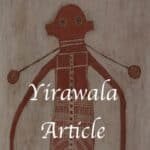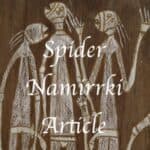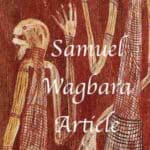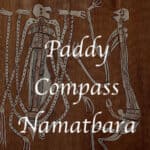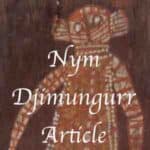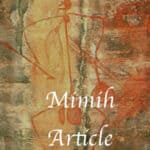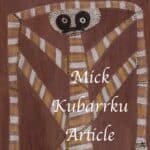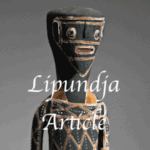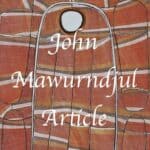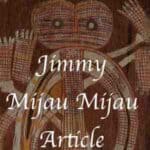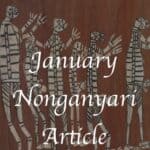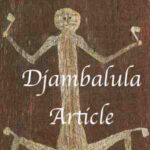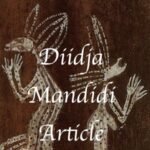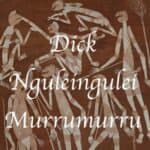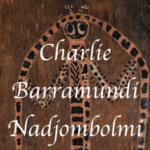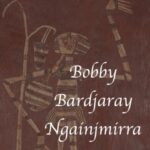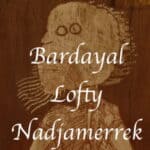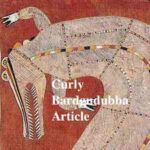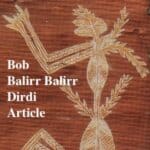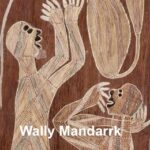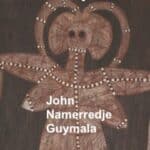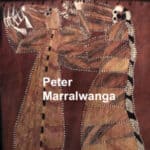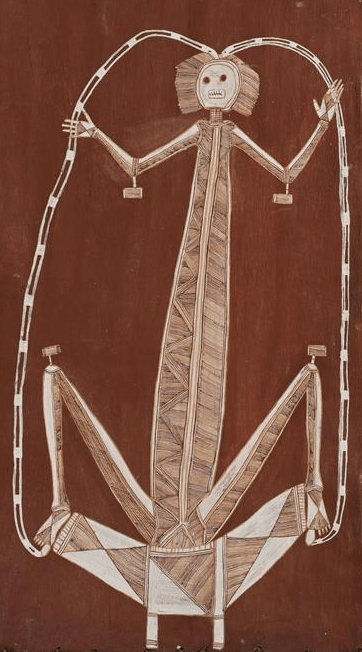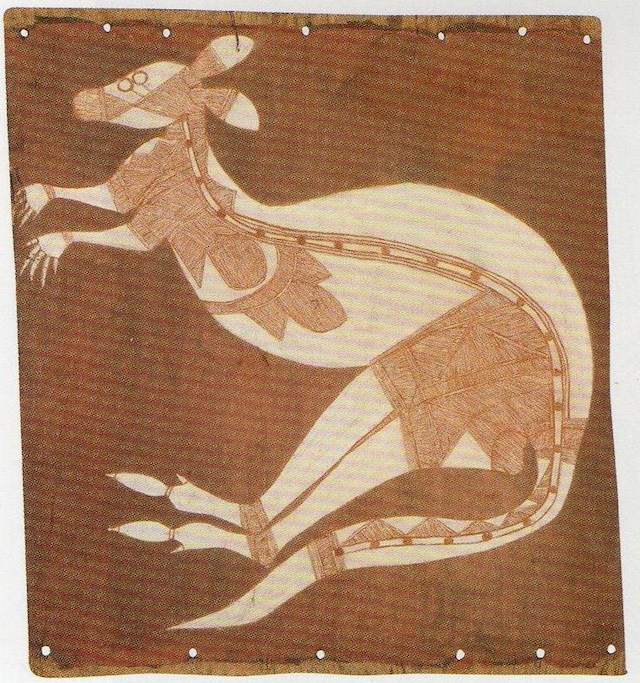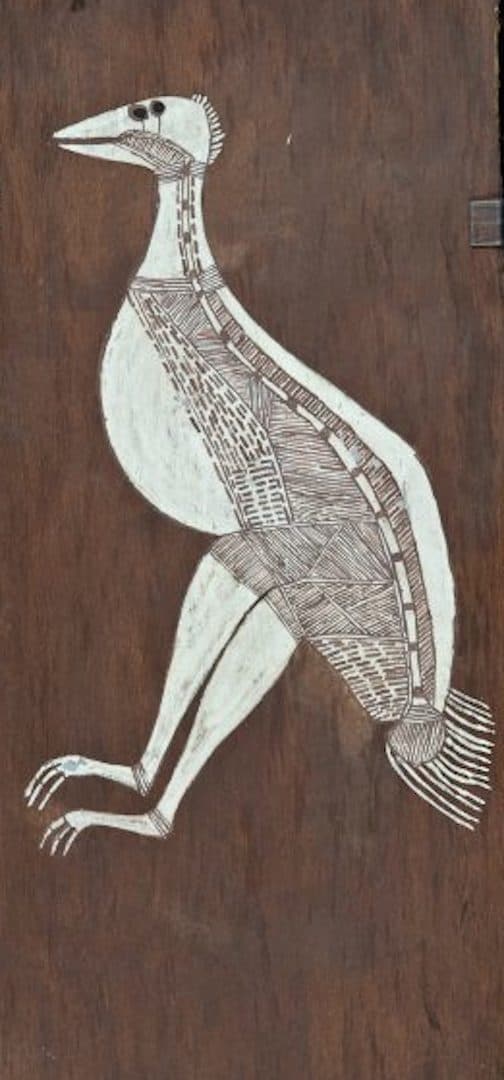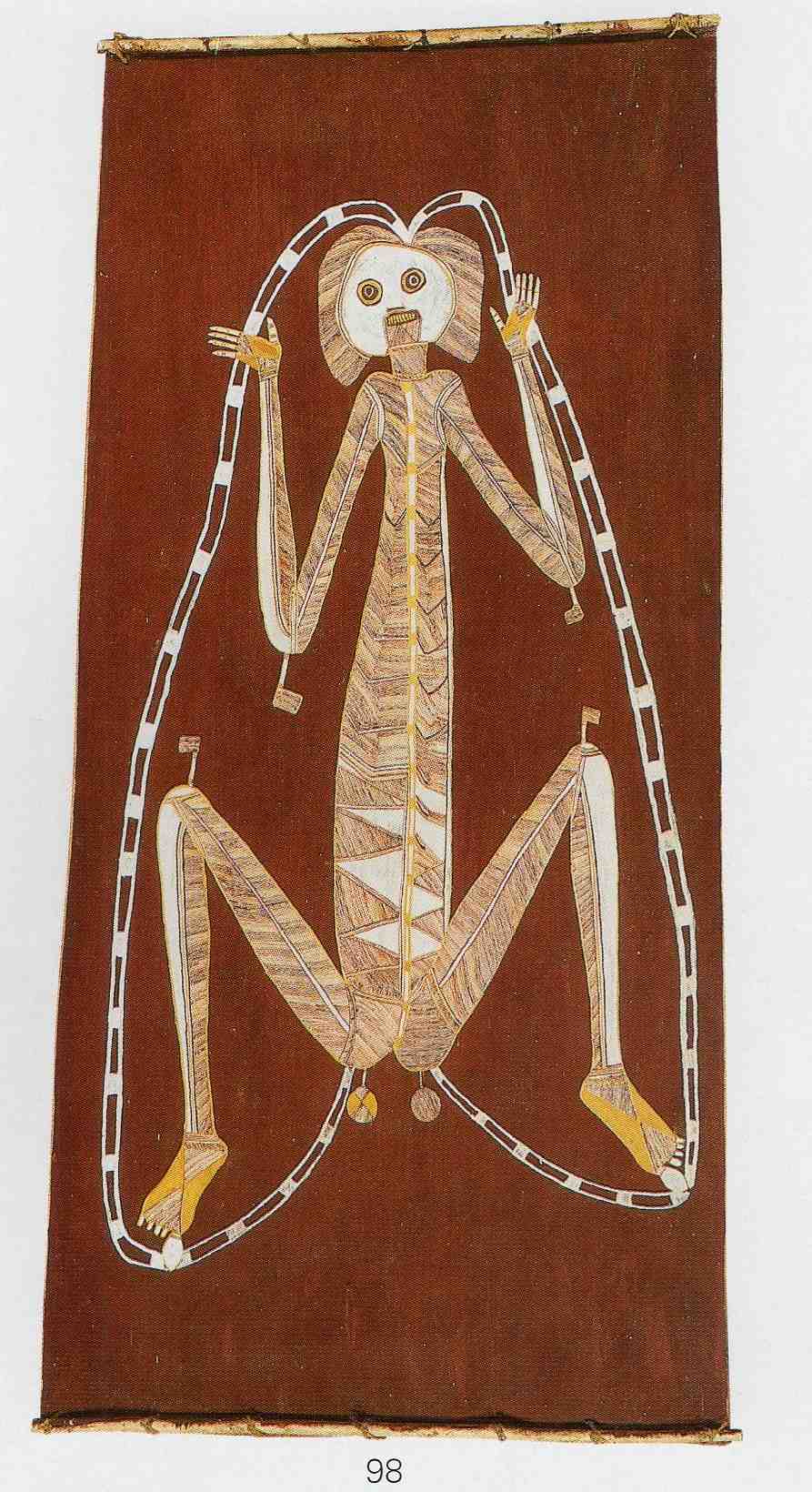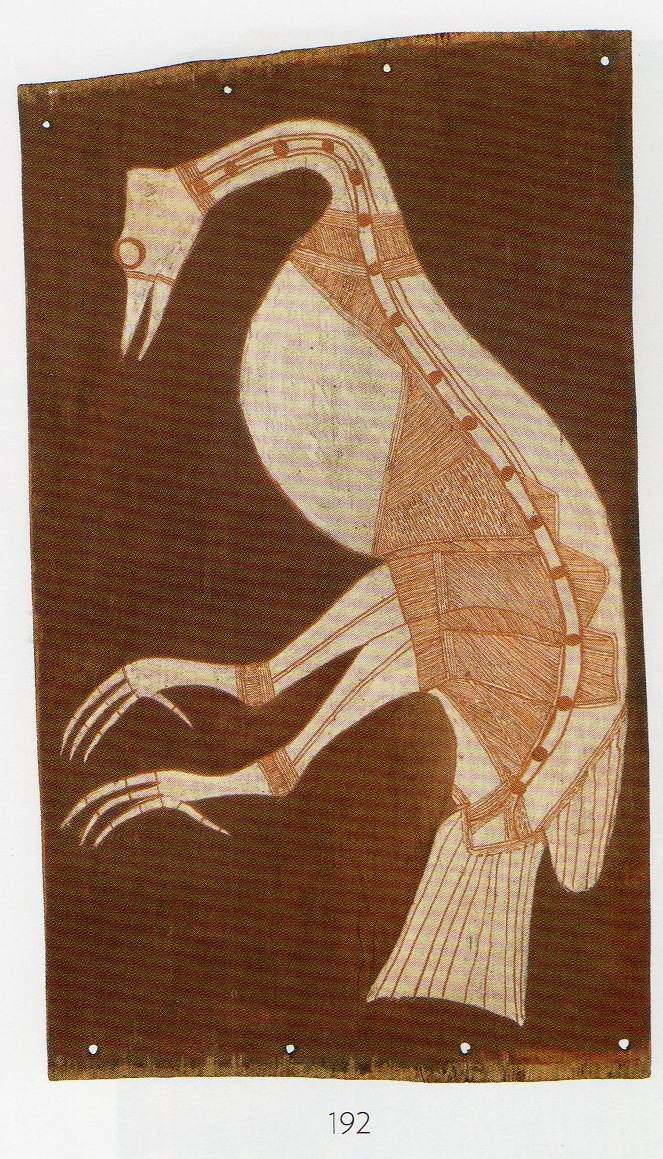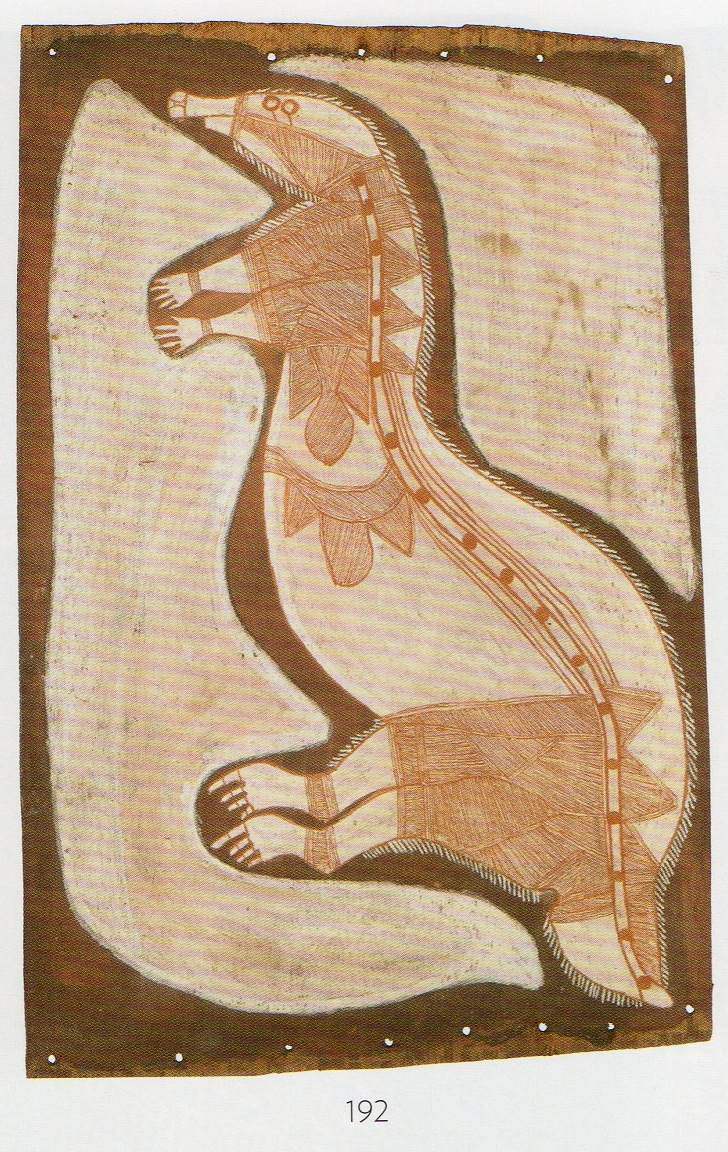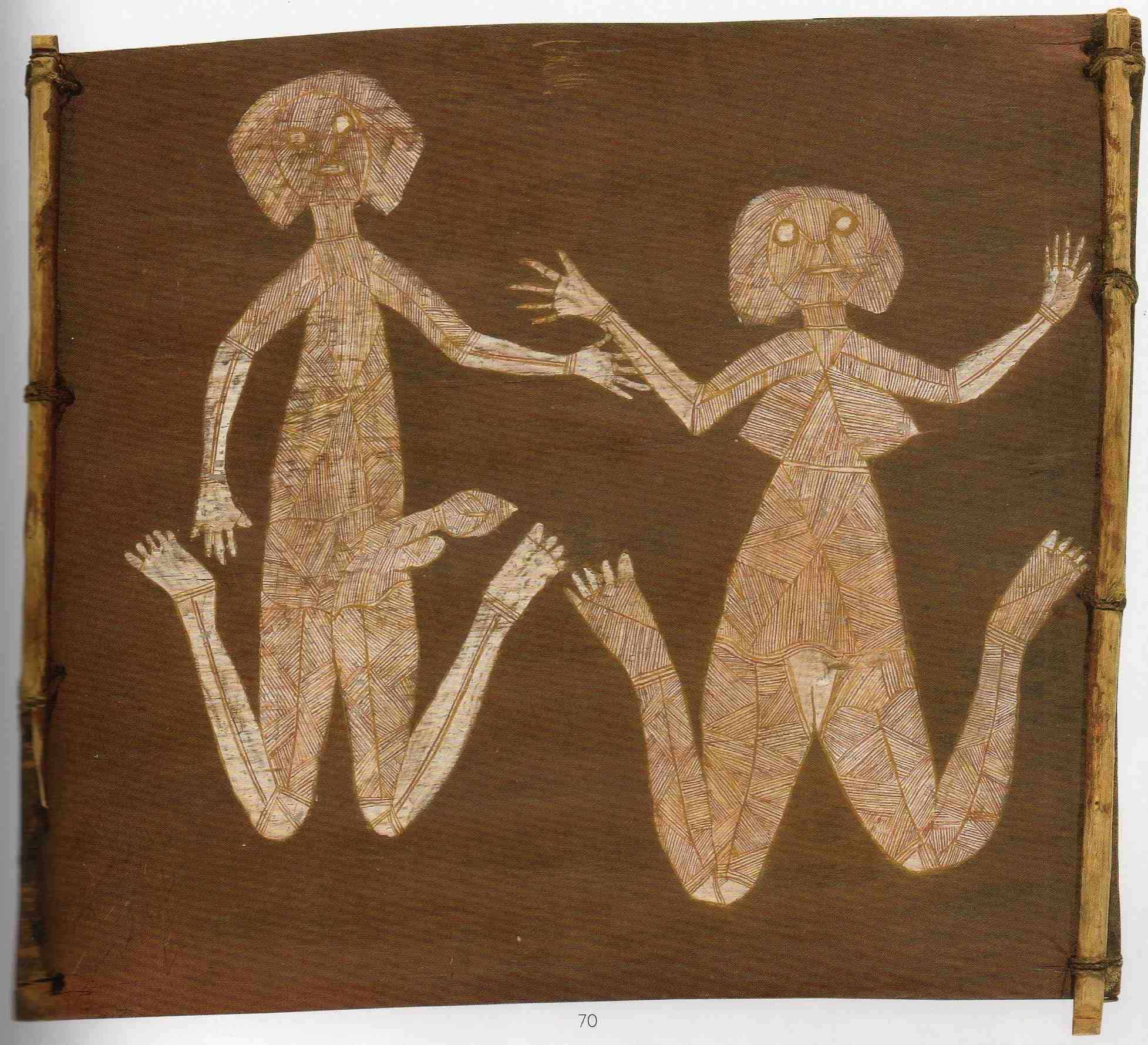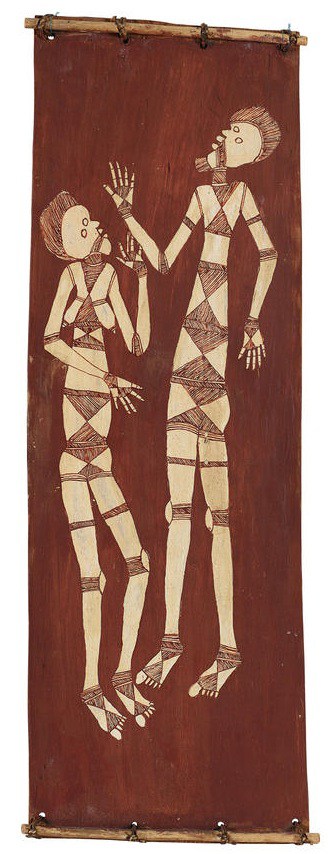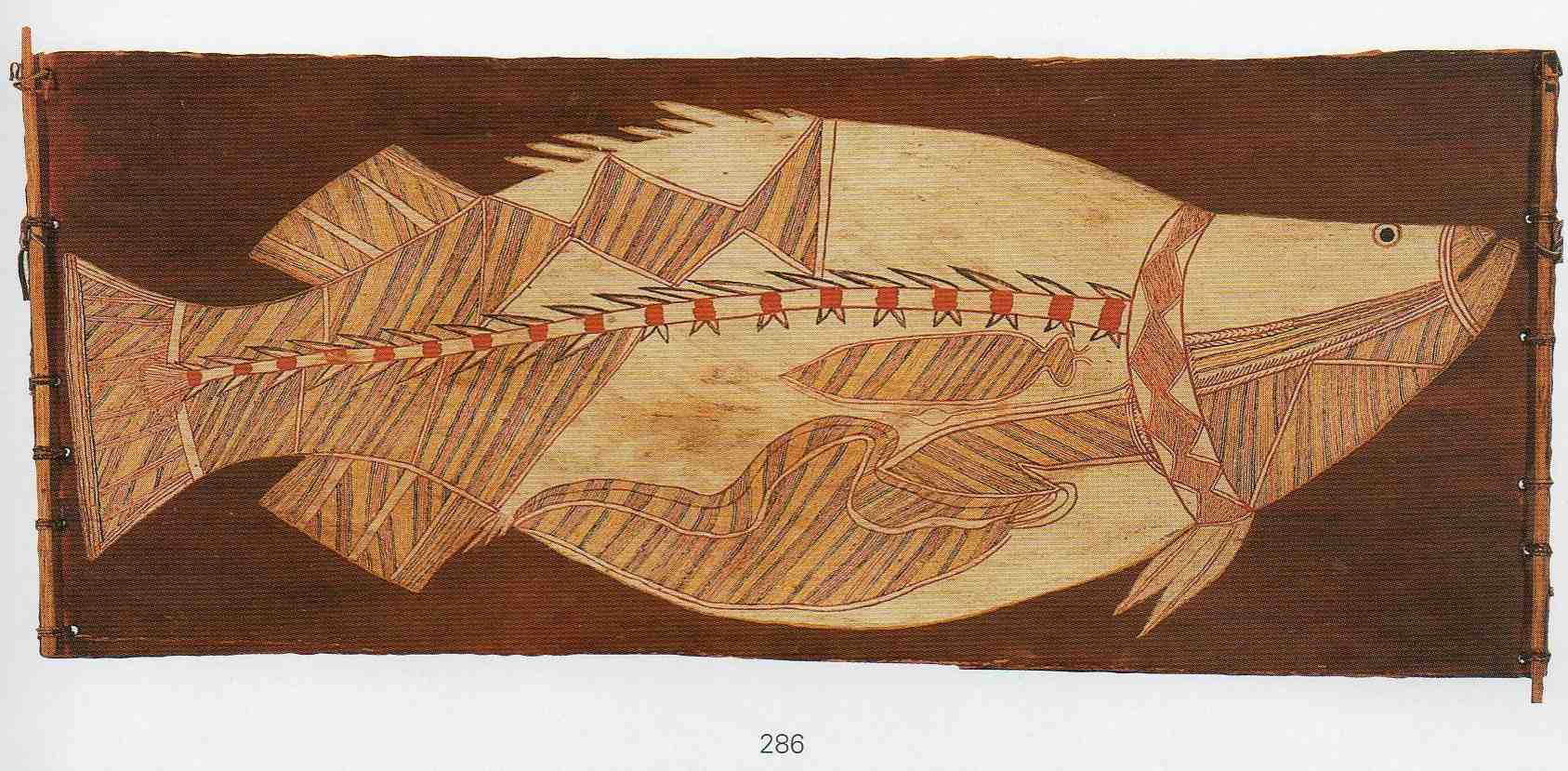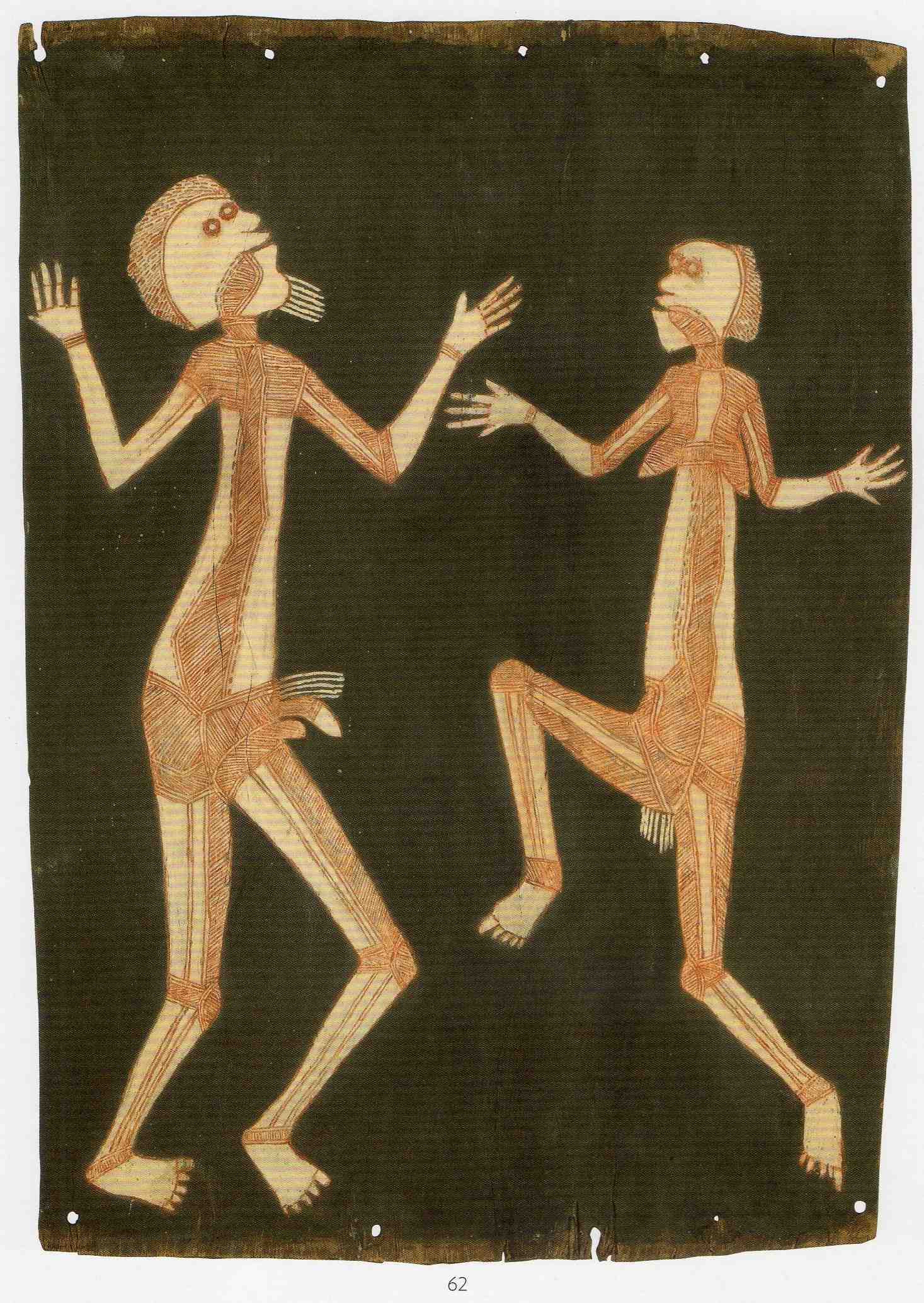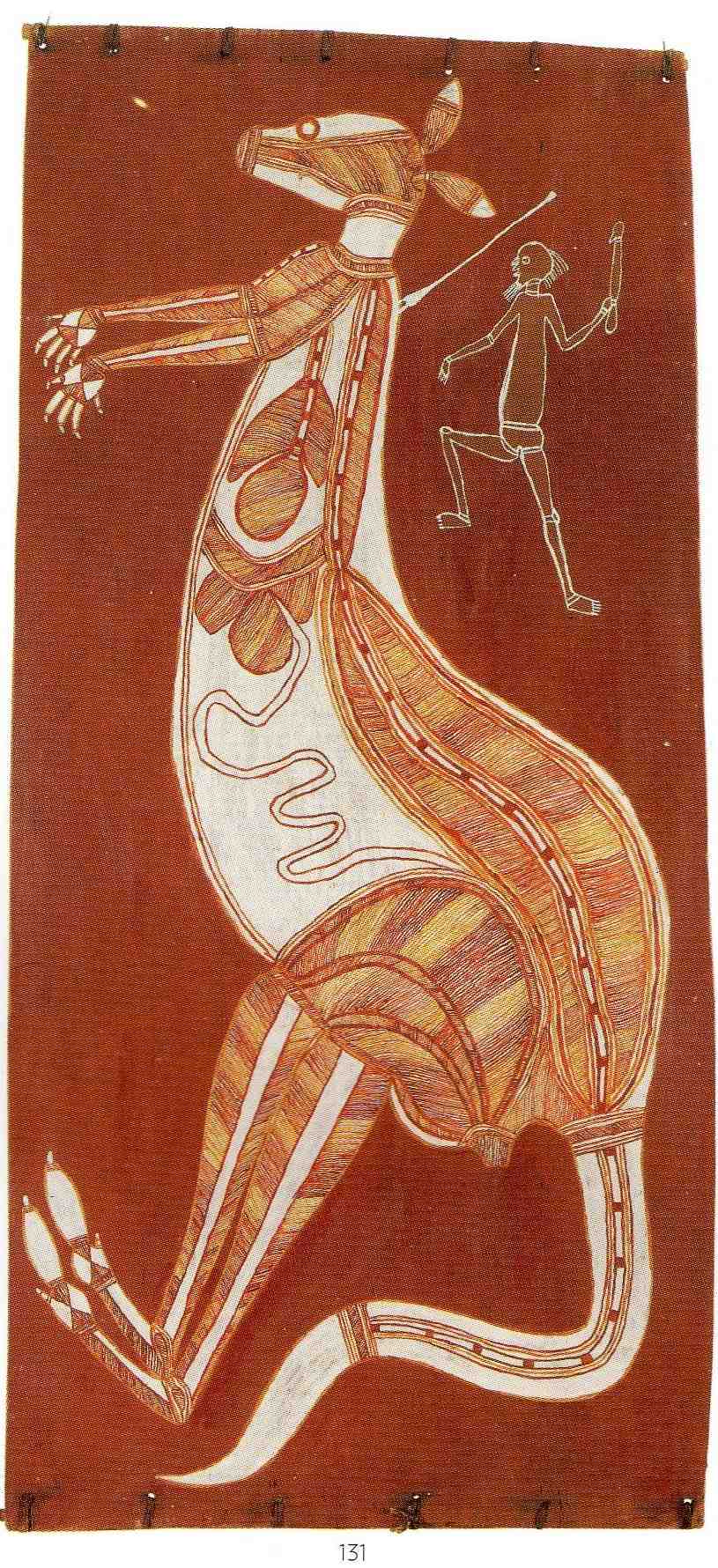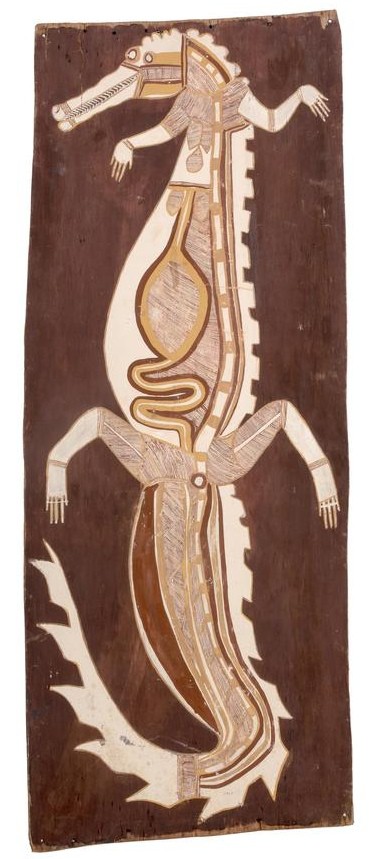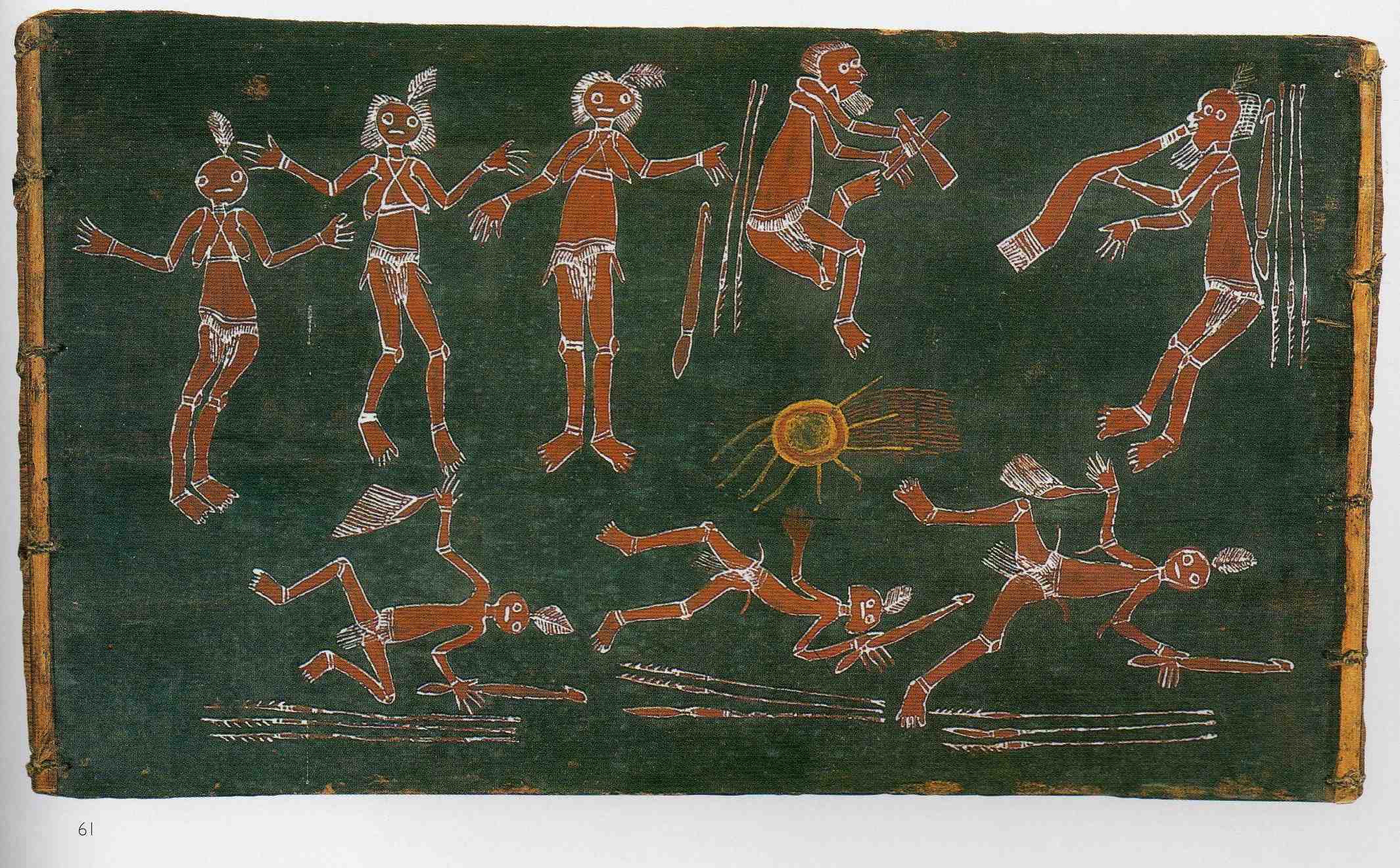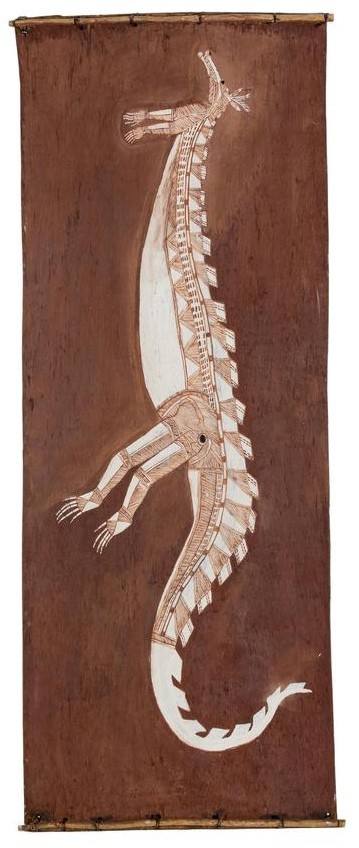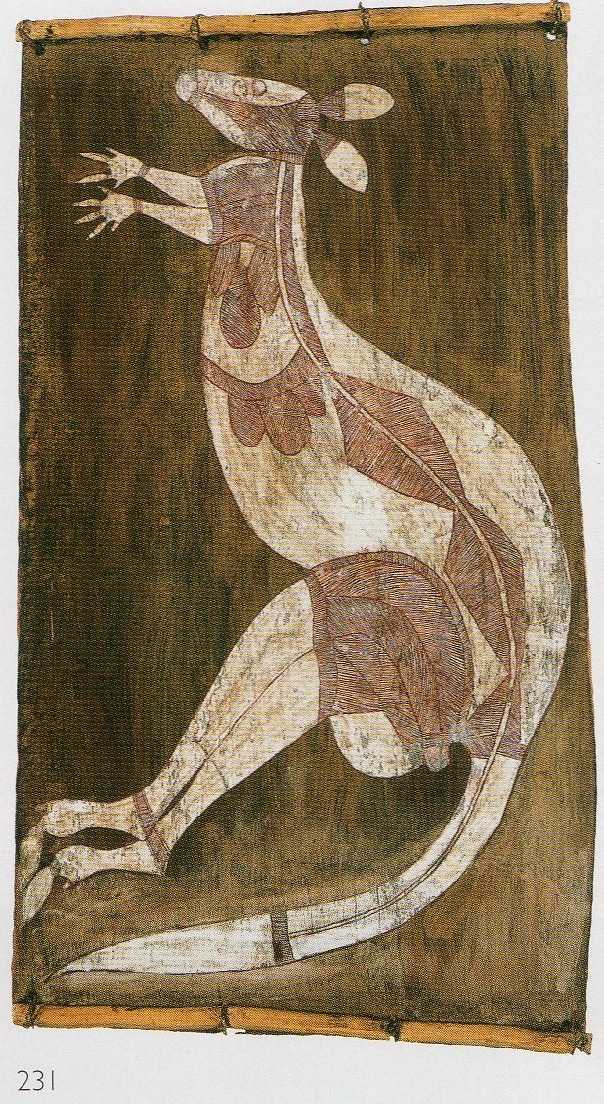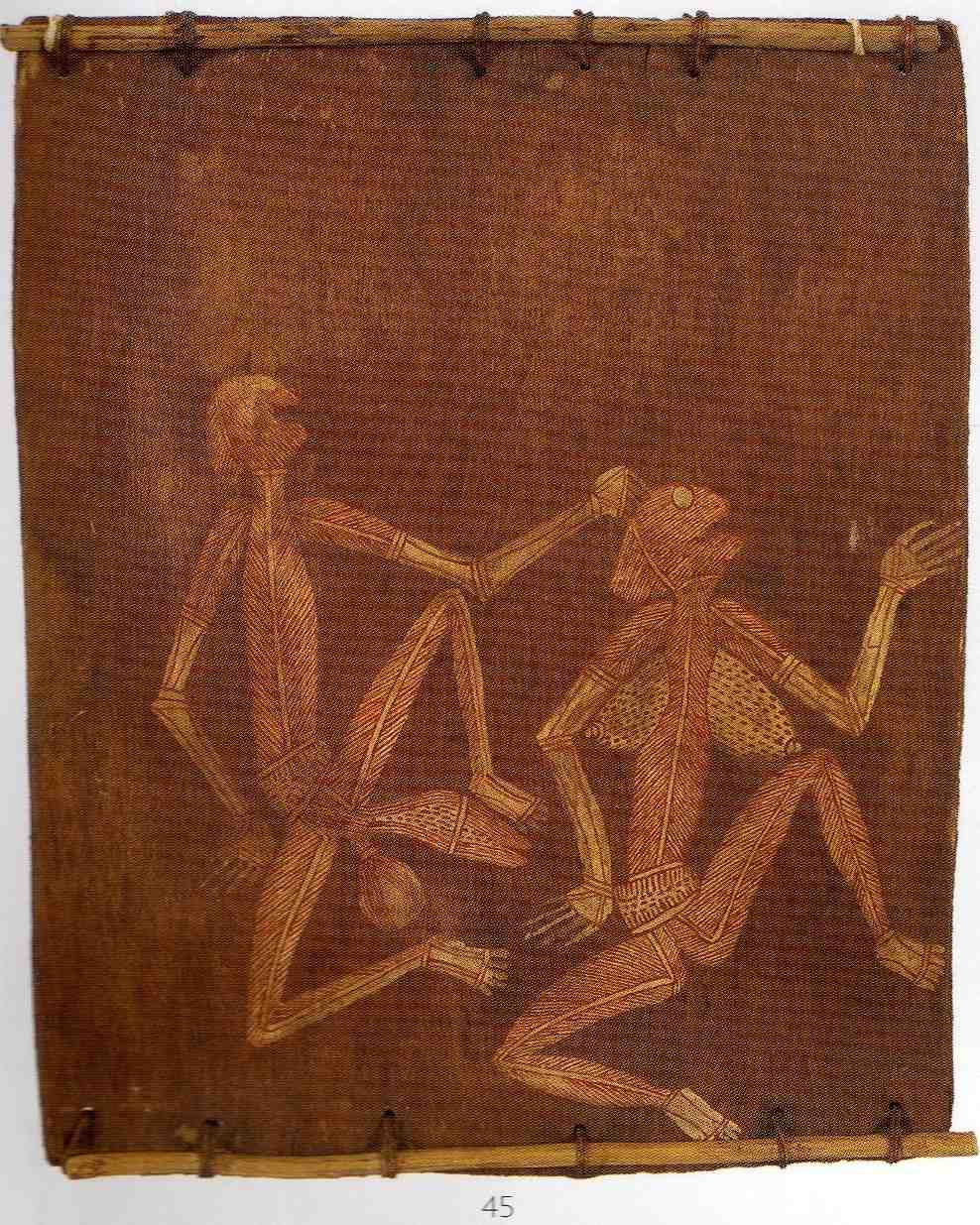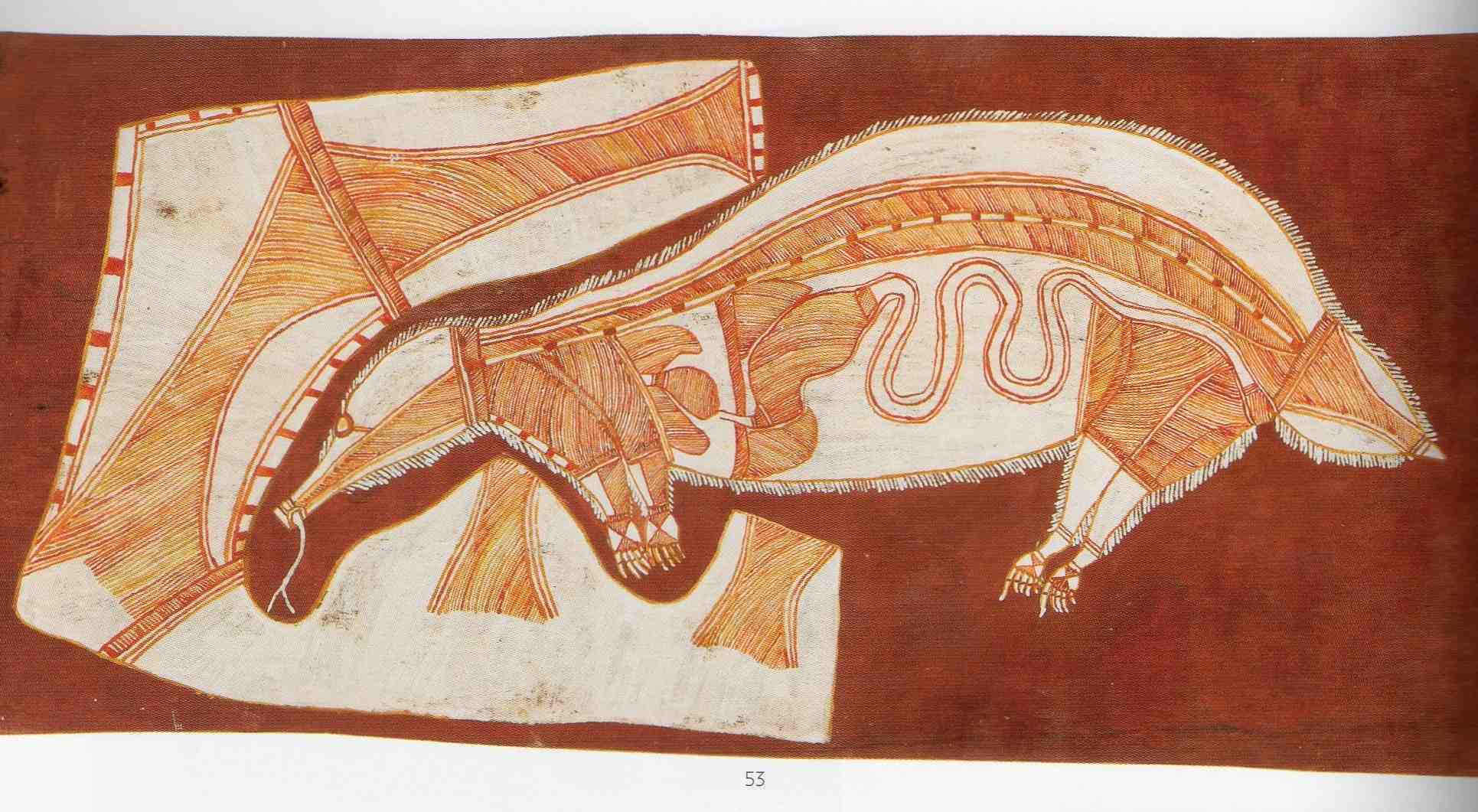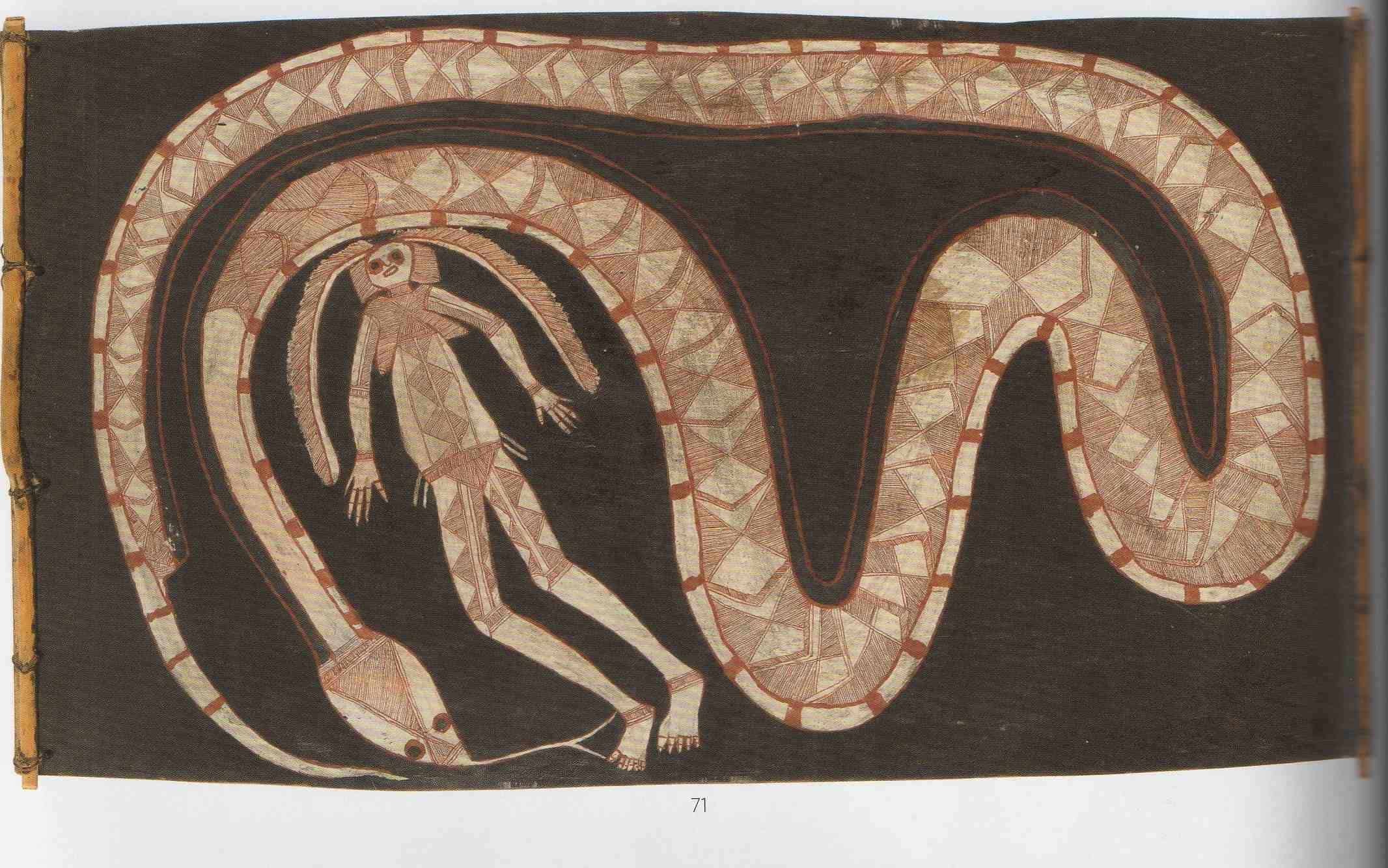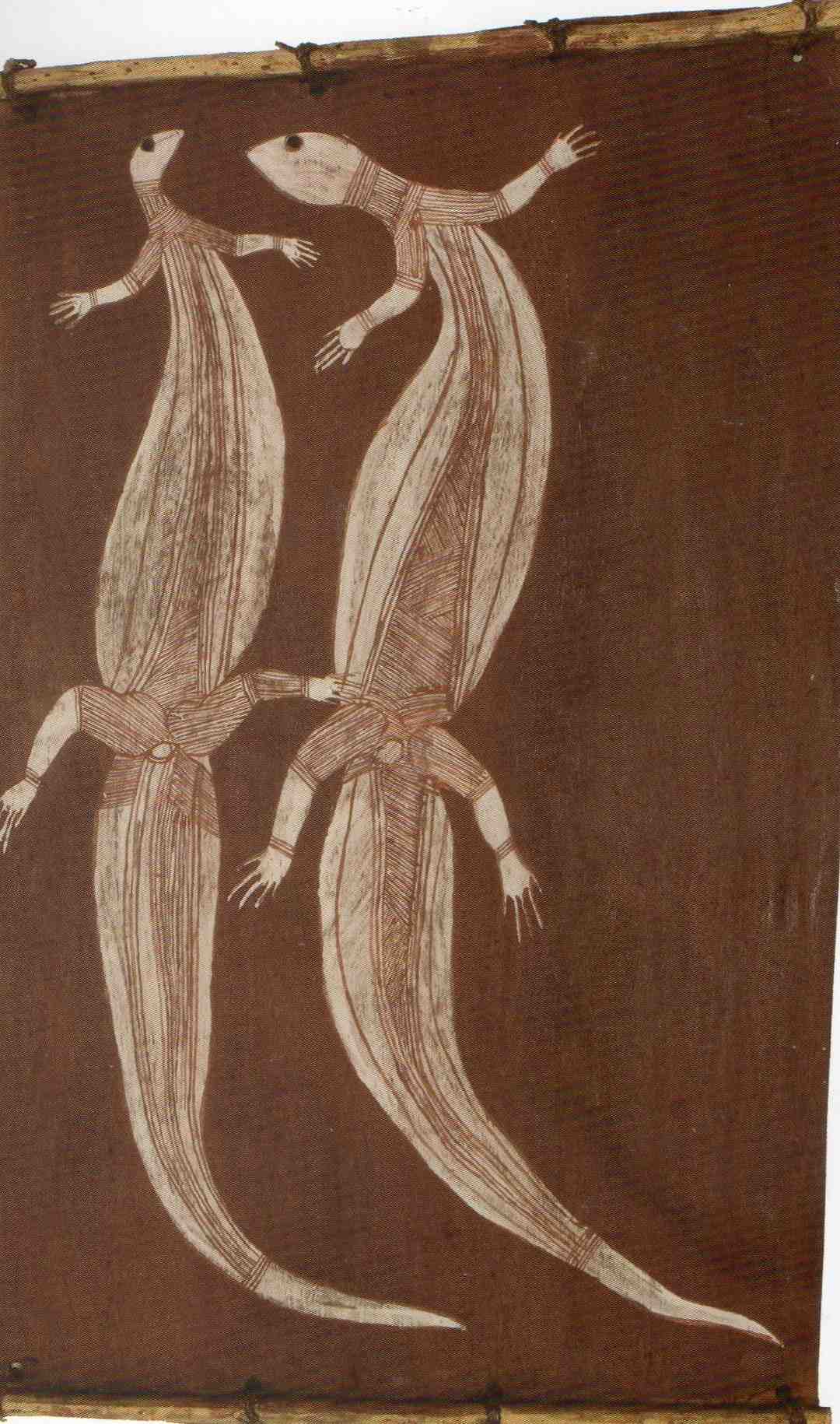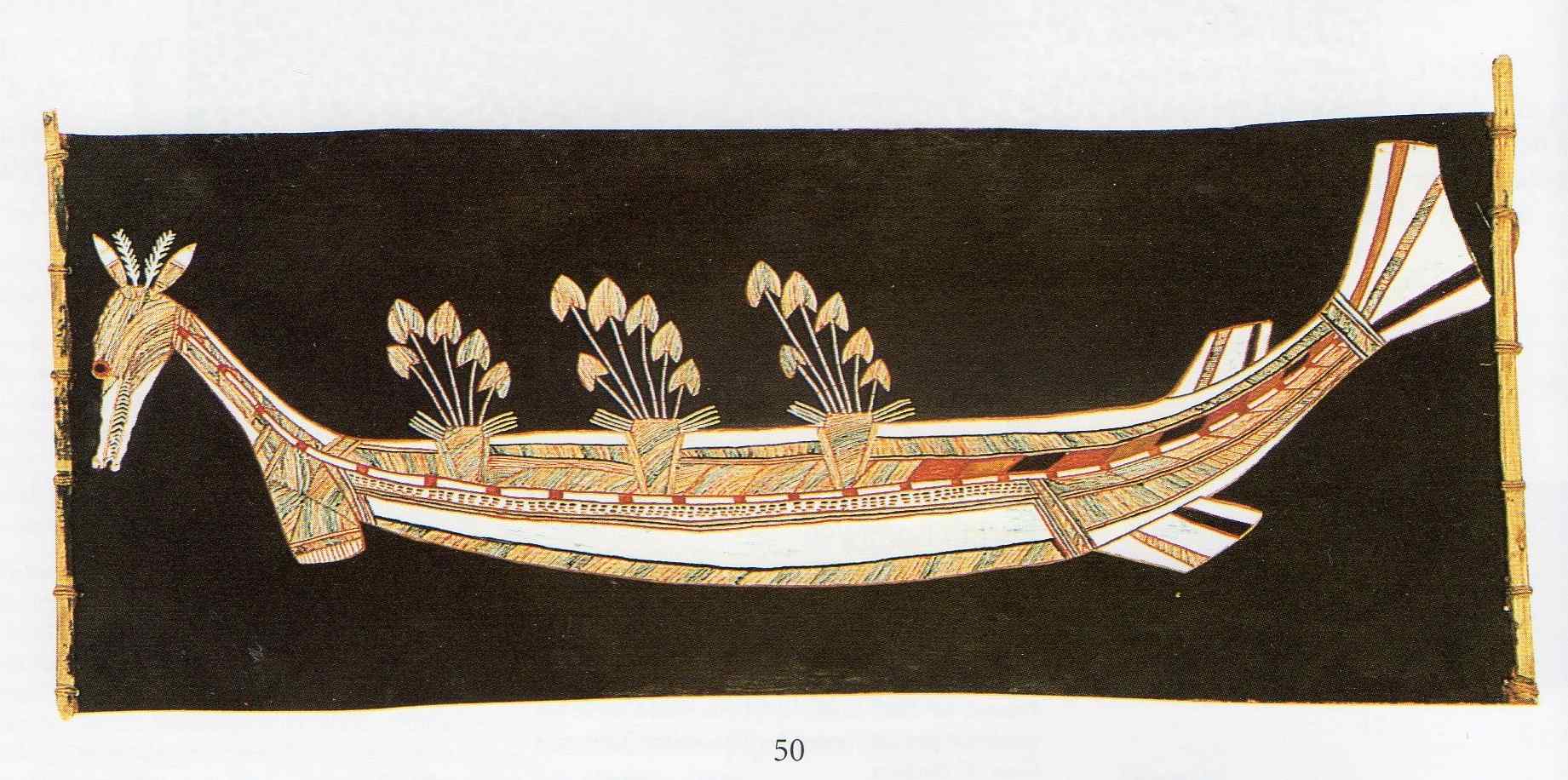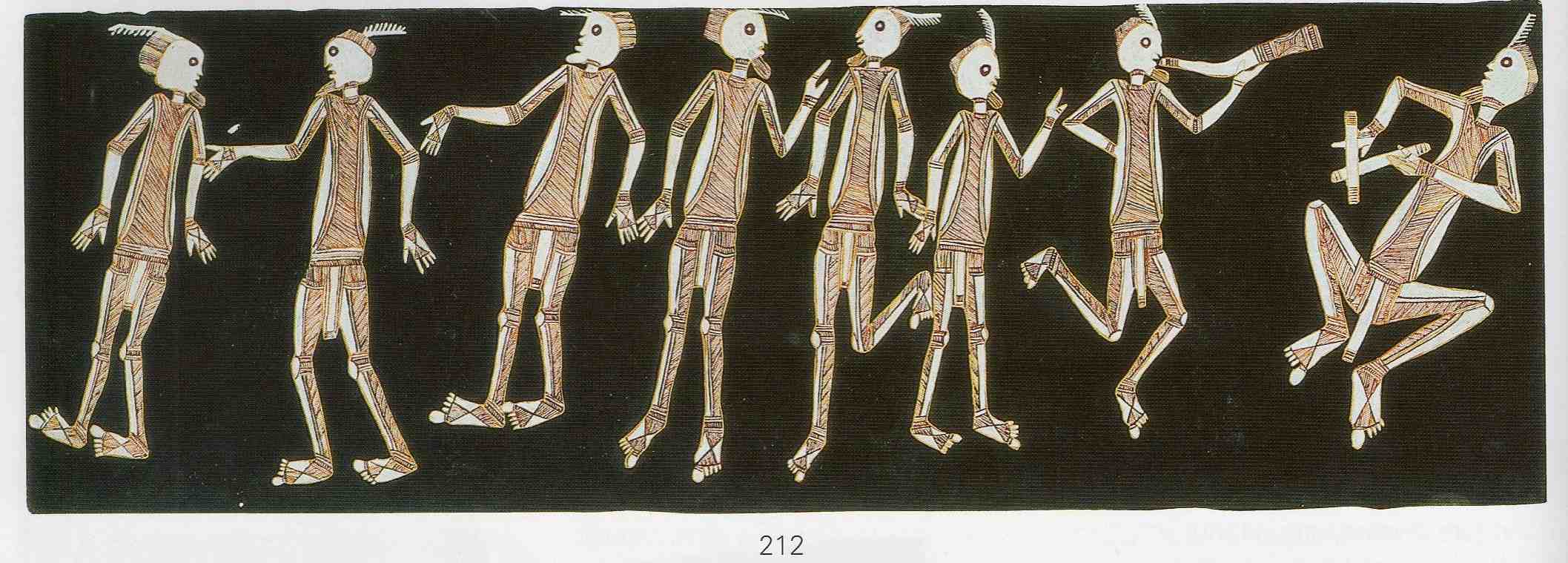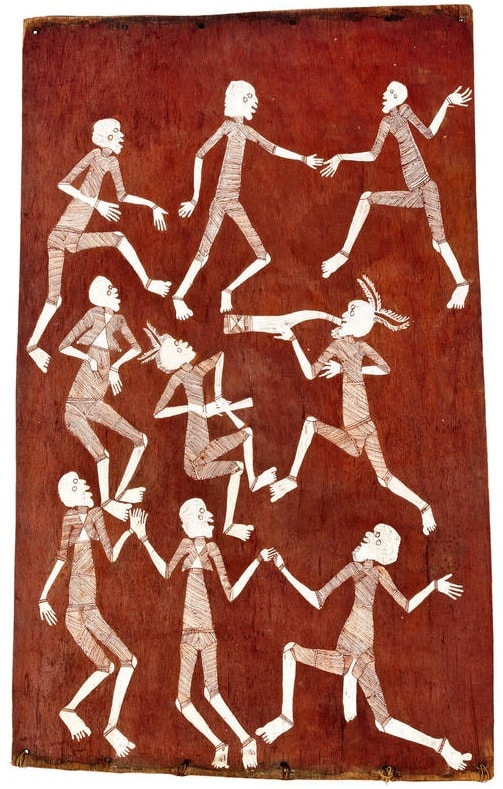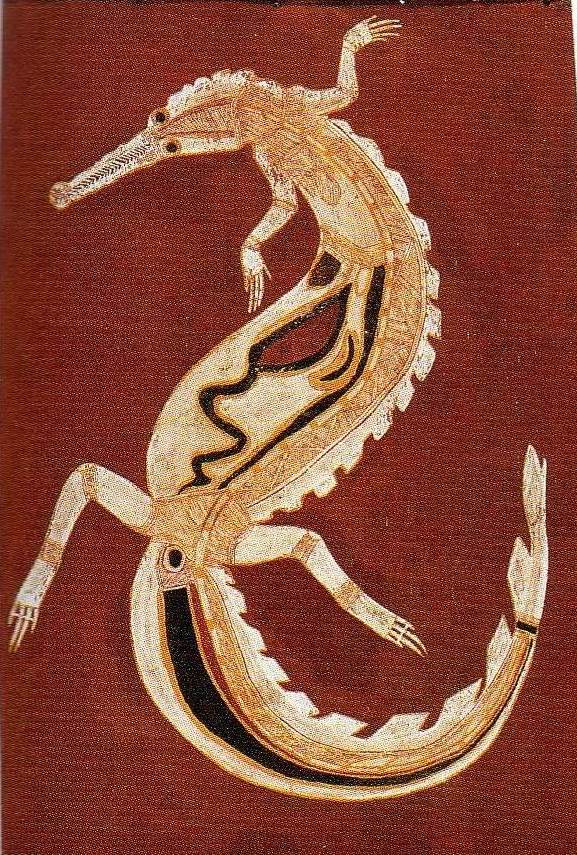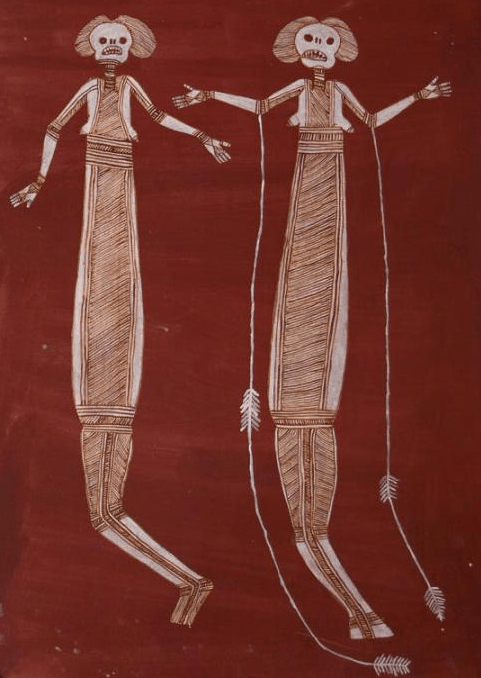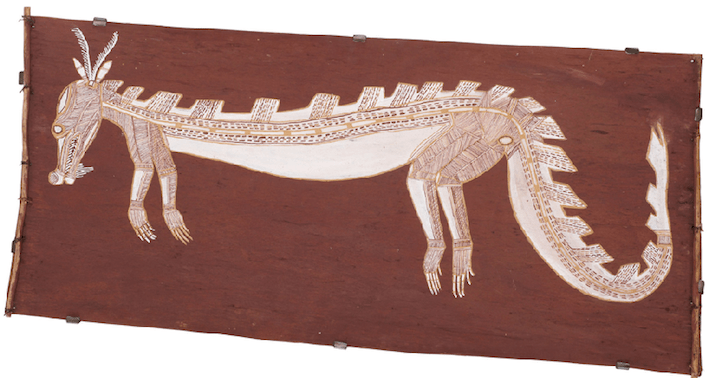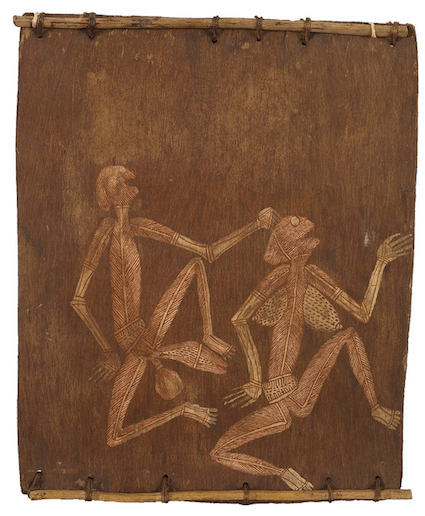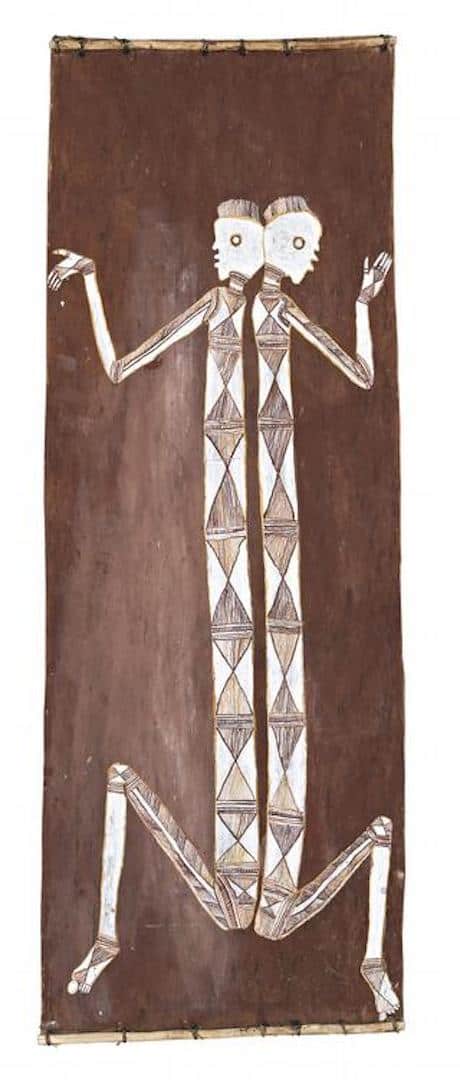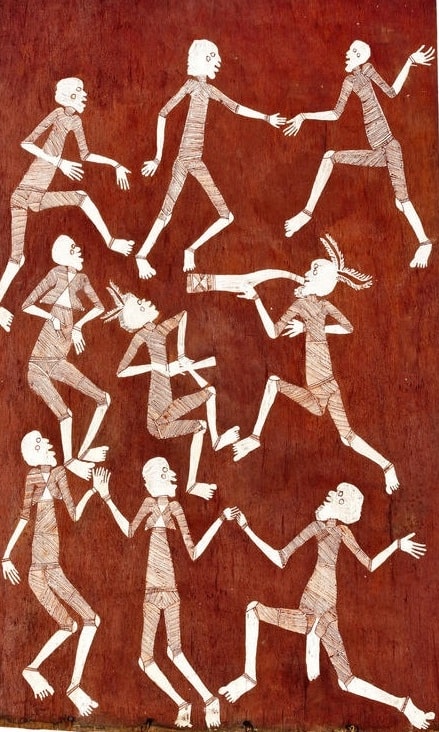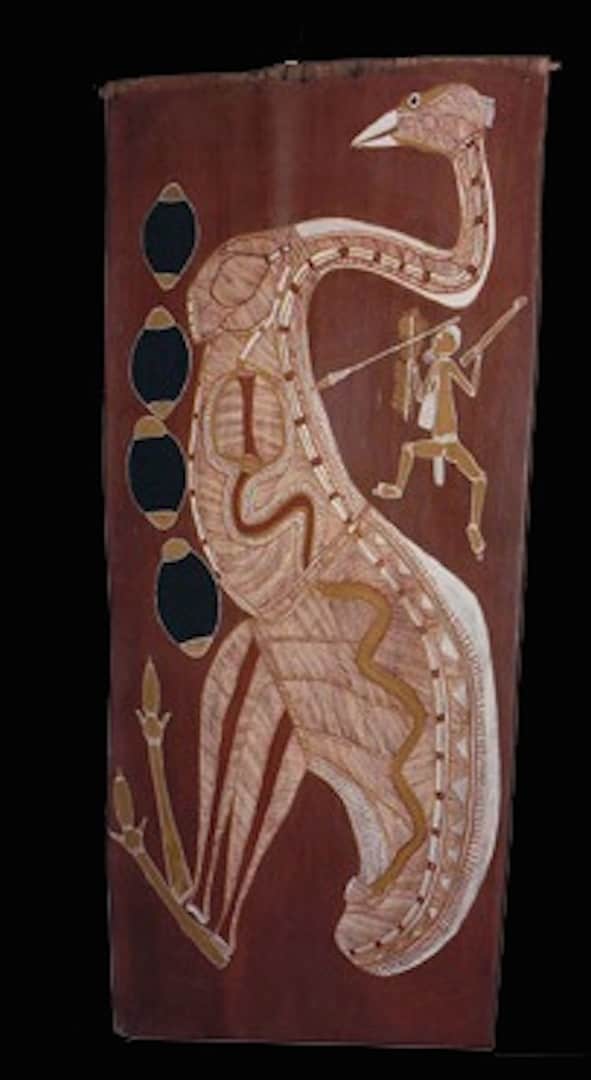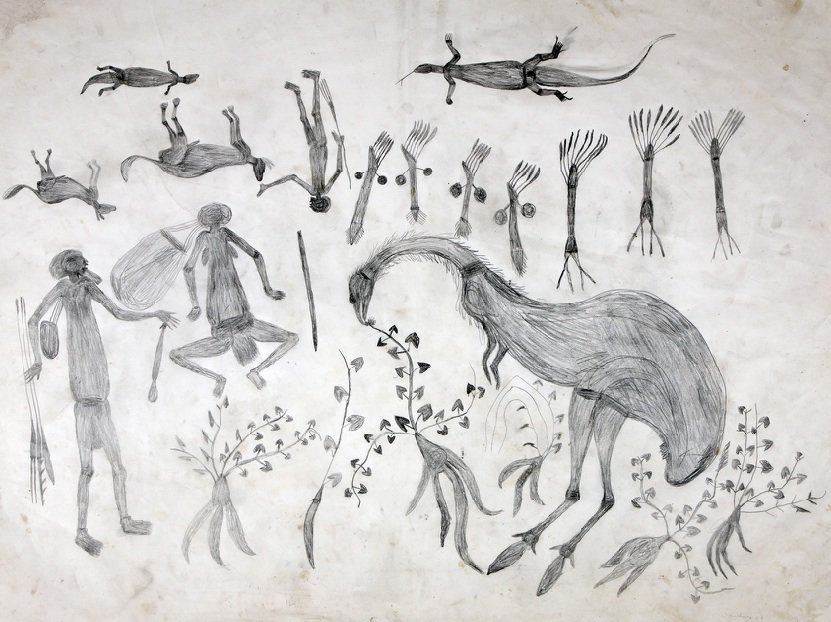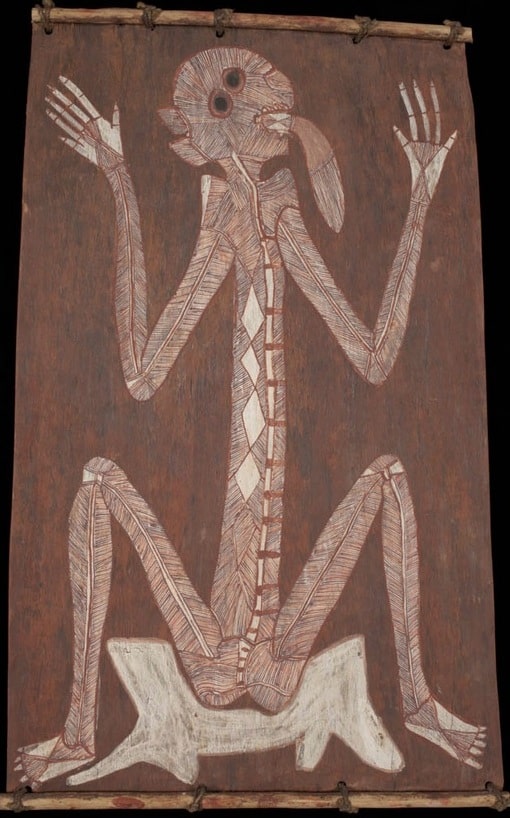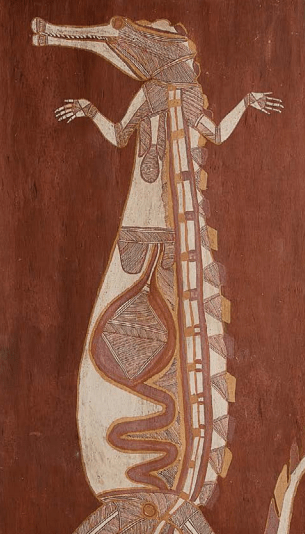Lofty Nadjamerrek : Master of oenpelli
I collect paintings by Lofty Nadjamerrek. If you have a Lofty Bardayal Nadjamerrek painting to sell please contact me
Lofty was born in 1926 in the Mann River area of Central Arnhem Land. He belonged to the Kunwinjku tribe. He started his painting career as a young man.
Lofty painted in Arnhem Land rock art shelters at the headwaters of the Liverpool River, south of Maningrida. He is one of the best painters in the x-ray style of bark painting, which the Oenpelli region is known for.
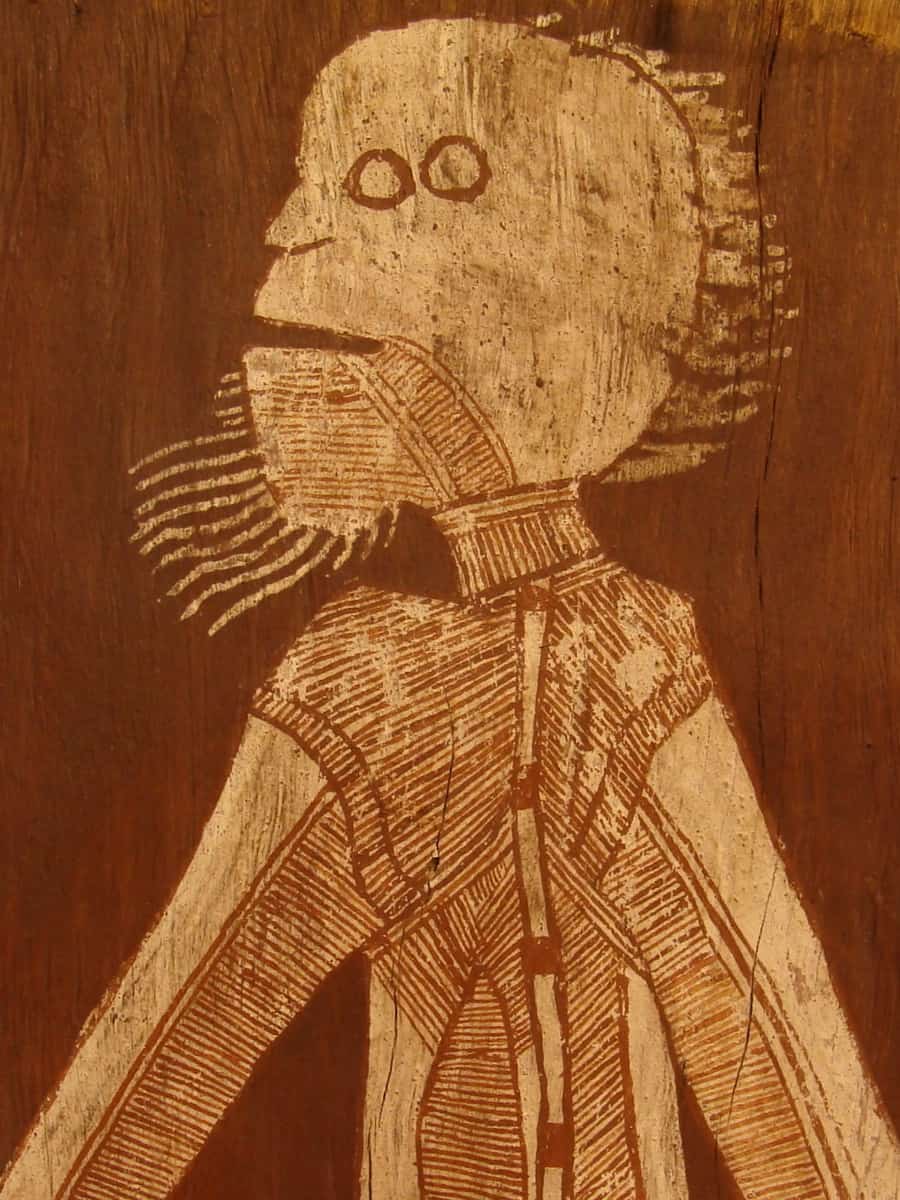
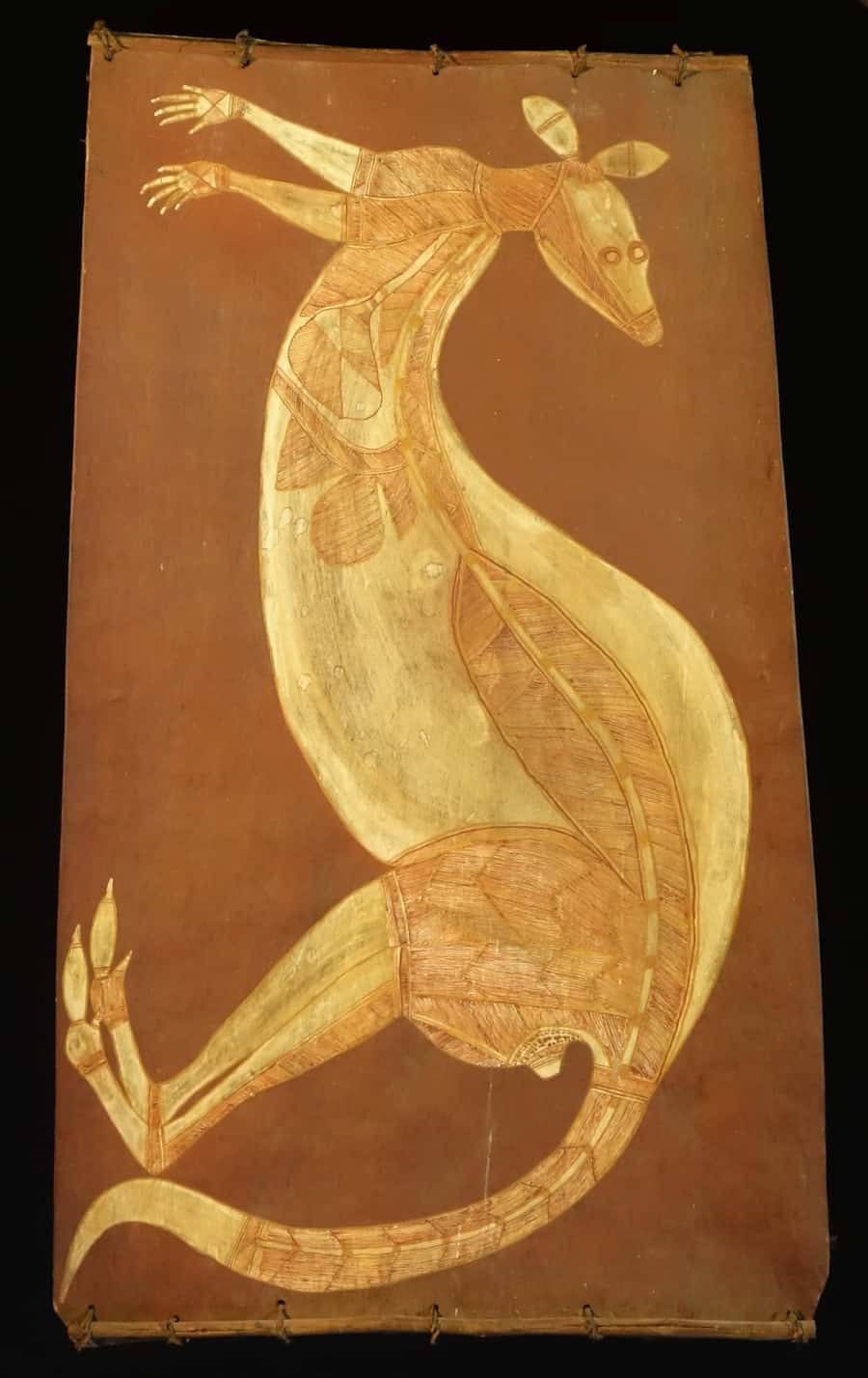
Lofty Bardayal Nadjamerrek Style
The high quality, intensity, and fineness of his parallel line hatching often distinguish Lofty’s work. He painted on Rectangular bark with either a red or Black background. Lofty Nadjamerrek does not use crosshatching but like Dick Murramurra preferred fine parallel line work. He usually shows the internal organs and spine on his figures and animals. This is the traditional way of showing that these are not mere pictures but real beings. His depictions of animals often have a sinuous grace that gives them a sense of movement.
Lofty did not attend a European school. Instead, he developed deep traditional knowledge. He was a guardian to many Western Arnhem Land customary stories. Lofty was initiated to the full complement of western Arnhem Land ceremonies. He was a much-respected traditional leader. Nadjamerrek also did much of his later work on paper. These paintings are collectible but I prefer his barks. Some of the most desirable of these later works on Paper depict the major Western Arnhem Land ceremonies.
He began commercially bark painting for the market at Oenpelli in 1969. Many of his bark paintings depict different animal species from western Arnhem Land. These include kangaroos, echidnas, crocodiles, birds, turtles and fish (Barramundi and catfish)
Biography
Compared to other Arnhem Land aboriginal artists Lofty Nadjamerrek was prolific. He is well represented in museums and collections. In the sheer number of works, he is only second to Yirawala. The length of his career, the sheer quantity of works means he was and still is highly sort after by collectors. Lofty’s paintings also have a certain European aesthetic. They are not as guttural as earlier painters like Djambalula or Diidja. Some of his later works on Paper and card are not covered in this article
Lofty Nadjamerrek is the only Aboriginal Artist to receive the Order Of Australia. This is the highest level of recognition in Australia. He passed away in 2009. His passing marked the end of an era of earlier Oenpelli Arnhem land bark painting.
Nadjamerrek was married, with five daughters and three sons. Unfortunately, none of his children followed in their father’s footsteps to take his place as a painter of exquisite barks. He painted throughout his life. In his last years, it was slow work due to his failing eyesight, caused by Trachoma.
Lofty rock art paintings of a kangaroo, emu, goats, and a horse and rider still survive in rock shelters today. They are at Kodwalehwaleh in Arnhem Land.
Lofty was also known as Nabadayal Bardayal or Nabardayal
References and Extra Reading
Keepers of the secrets: Aboriginal Art from Arnhemland
Crossing Country: The Alchemy of Western Arnhemland Art

Rainbow Serpent
Lofty is particularly well known for his images of Namarrkon the lightning spirit and Ngalyod the rainbow serpent. His bark painting can capture the transformational powers of these beings.
There are three known Rainbow Serpents in western Arnhem Land. The most powerful one is the Jingana, the Mother Serpent, who lives either underground or in lagoons covered in waterlilies.
In earliest times Jingana became dissatisfied with the shapes of the inhabitants populating the area. Creatures were half human, half bird, fish or animal. So she swallowed everything and then regurgitated them in the forms they bear today.
Then she grew two eggs in her belly, and eventually gave birth to a son and a daughter. The son, Ngalyod, had the head of a crocodile, the body and tail of a serpent. The daughter, Ngalgunburijaimi, also had a crocodile head and serpent body, but the tail ended in a fish tail. Both the son and the daughter had bony protuberances like a hump in their chest, and spurs like feathered streamers growing from their head.
Ngalgunburijaimi
It is the daughter rainbow serpent, Ngalgunburijaimi, who is featured in this painting.
The three rainbow serpents are much feared, and all are given due respect in sacred ceremonies, to keep them even-tempered. Because if they become angry they are quite capable of swallowing people who break the law. During the dry season the serpents stay sheltered in their waterlily billabongs, but at the beginning of the wet they sit up on the stormclouds which they have created from the vapour from their mouths. Thunder rolls across the skies as they growl, forked lightning is caused by their flicking tongues and when the same tongues prick the stormclouds, torrential rain descends over Arnhem Land.
If they are angry, however, they can create storms in the dry season and so destroy the balance of seasons. Aboriginals take great care not to incur their wrath and keep well away from billabongs where they know the serpents live. For if they go close they could destroy the cabbage tree palms growing on the banks and so destroy the food which the serpents live on.
Mimih Hunter Dreaming
This painting depicts a traditional story of the meeting of Mimih by a hunter called Djala.
Djala and his heavily pregnant wife lived near the rocky escarpment known to be the home of the Mimih. The Mimih was a tall but very slender form of spirit people who lived hidden in caves and had dangerous magic.
Djala went hunting and was tracking a large kangaroo and near sunset, he discovered a Mimih had killed the kangaroo he was tracking. Having seen the Mimih kill the kangaroo with his spear Djala complimented the Mimih on his skill. The Mimih called Kaman invited Djala back to his camp to share in the kangaroo meat. Djala was hesitant because he knew the legend that if a Mimih came in possession of your hair or sperm they could work magic on him.
The Mimih blew upon a rockface and it split in two leaving a passage to the Mimih secret glade. In the grassy glade Kangaroos grazed unfrightened and at the far end of the glade was a cave. In front of the cave other Mimih were singing and dancing. The Mimih women were larger and fuller with large firm breasts. Kaman the Mimih introduced the human visitor and instructed his wives to cook.
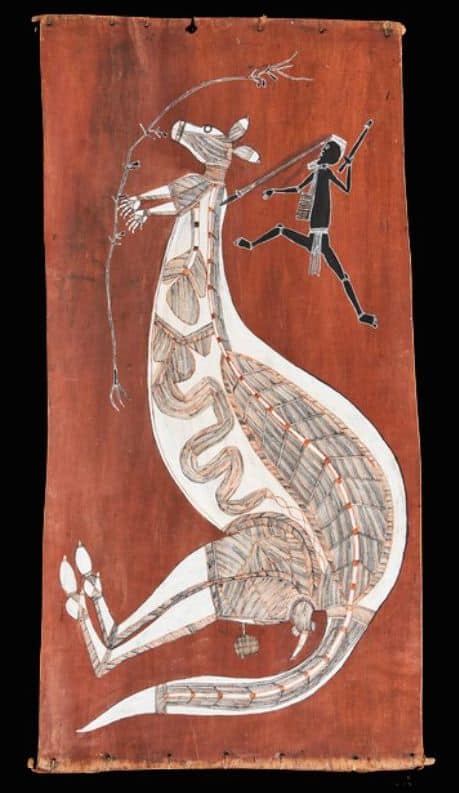
Realizing if he ate the magical food he would never leave the camp and see his wife again Djala tried to leave. He asked politely if he could take a section of the kangaroo and walk back to his camp. Kaman put him off and insisted he stays the night. With Mimih women singing he fell to sleep into a deep sleep in the cave. He awoke feeling the fingers of Kaman’s wives stroking him all over. He faked sleep knowing that if they knew he was awake he would be seduced and become one of them.
In the early morning by the light of the stars, Djala crept out of the Mimih cave and glade and returned home to his wife.
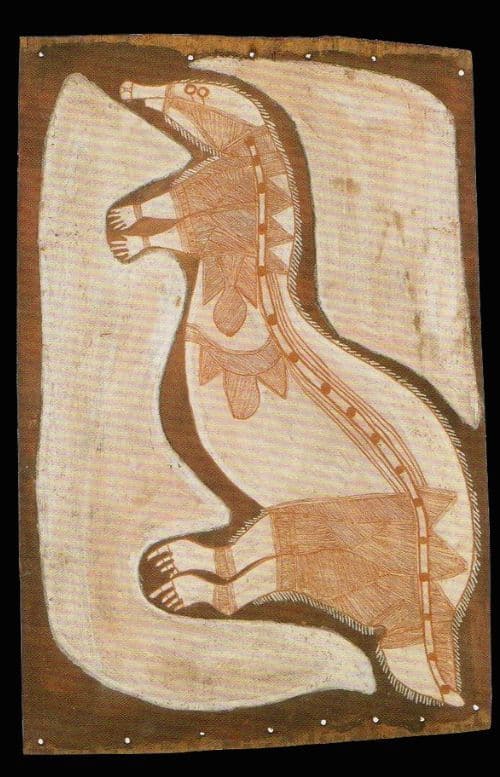
Ngarrbek, the Echidna
Western Arnhem land Artists and Artworks
Lofty Nadjamerrek Images
The following images are not a complete list of the artists works. They do however give a good idea of his style and variety

